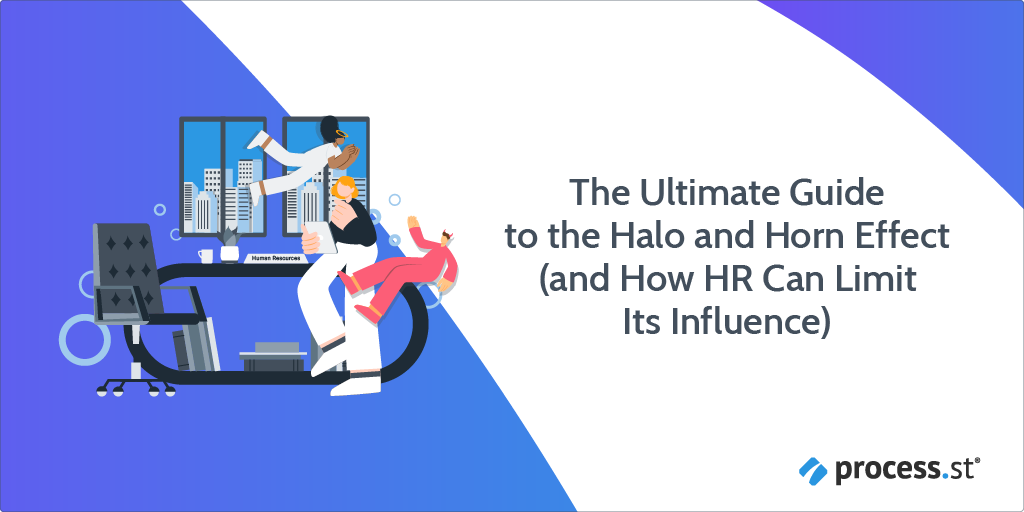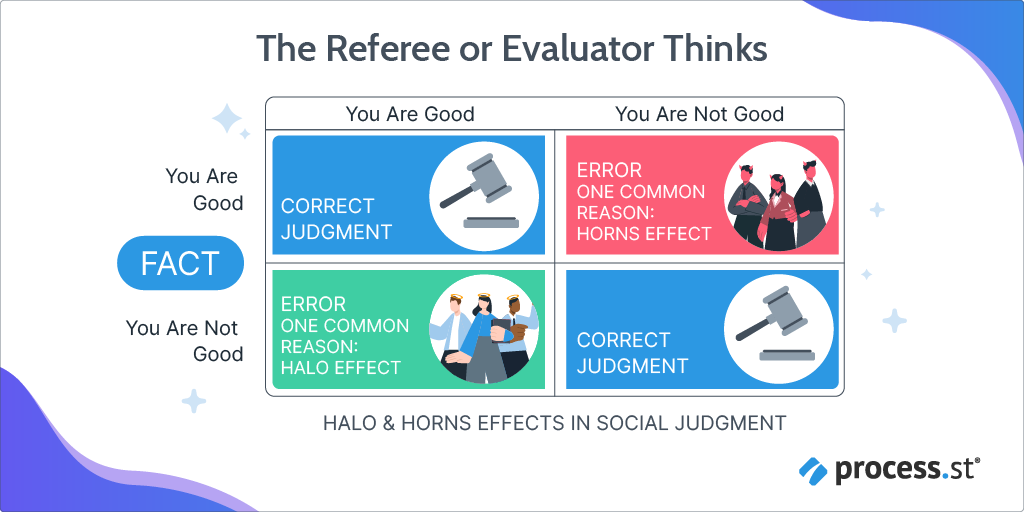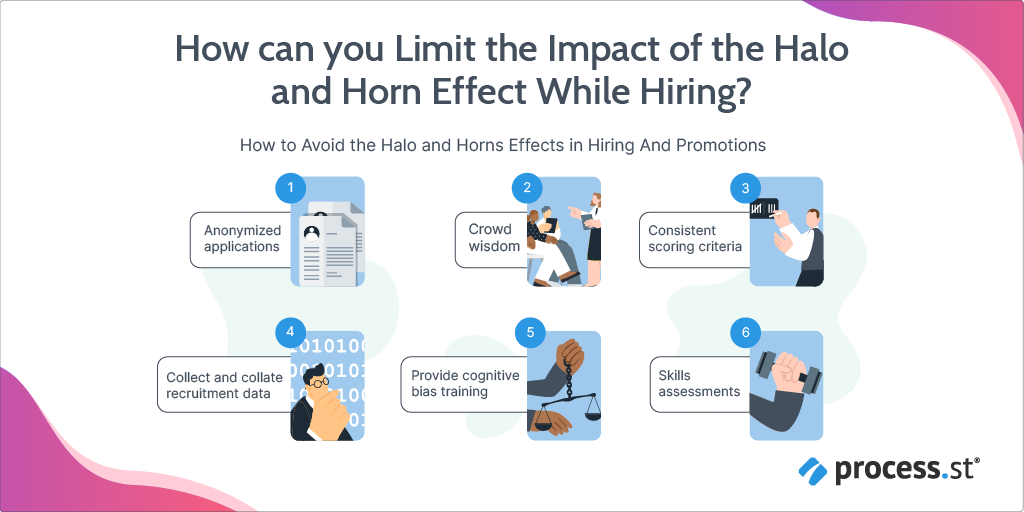
You judge people all the time!
But that’s okay, because we’re all guilty. This is specifically the case when we look at the workplace. Hiring managers make these snap judgments each day – and get paid for it.
Our first impression of someone sticks. We’re then unconsciously looking for signs that confirm our first impression to be right – even when it’s not.
Think of it this way: A candidate is late for their first day – the impression is that they’re always late. Now, whenever they arrive late, it confirms the impression that they’re always late. Even if they show up early or on-time most days.
Please welcome unconscious and confirmation bias – the byproduct of the Halo and Horn Effect.
This sociological theory doesn’t only exist on page. And it isn’t limited to our interpersonal interactions either. The workplace is a breeding ground for biased opinions and quick judgment calls, especially when hiring.
To stop the Halo and Horn Effect from influencing your hiring decisions, you first need to understand how this bias creeps into how you perceive others.
- What is the Halo and Horn Effect?
- How does the Halo and Horn Effect influence hiring decisions?
- How the Halo and Horn Effect form part of unconscious bias
- Why is the Halo and Horn Effect bad?
- How can you limit the influence of the Halo and Horn Effect?
- Stop judging a book by its cover
What is the Halo and Horn Effect?

The Halo and Horn Effect is a type of bias formed when an employee is either highly-competent or incompetent in one area. A supervisor then takes this observation and rates the employee as being highly competent or less competent in all areas.
It’s common to see the Halo and Horn Effect in hiring. Often the first impression of an employee overshadows their positive or negative attributes.
What is an example of the Halo Effect?
American psychologist Edward Thorndike invented the Halo Effect theory in the early 1920s. In his experiment, he found that conventionally-attractive people were typically perceived as successful and competent.
From his findings, he notes that one redeeming aspect of a person leads individuals to cast this person’s character in a positive light. This results in all negative characteristics being overshadowed.
For example, a conventionally-attractive person might have one redeeming quality, which is a friendly demeanor. Because of this quality, their negative characteristics, like frequently missing deadlines or poor punctuality, don’t seem as problematic and disruptive.
What is an example of the Horn Effect?
The Horn Effect is the opposite of the Halo Effect. It’s the cognitive process where an observer ascribes negative behaviors or attitudes to someone based on one character trait and/or their appearance.
For example, an overweight person is often stereotyped as being irresponsible, slovenly, or lazy.
How does the Halo and Horn Effect influence hiring decisions?
Whether made during face-to-face interviews or on paper, first impressions stick during the hiring process. More often than not, these first impressions are made based on the Halo and Horn theory.
Although making these quick judgments are so common, we all understand that these initial impressions are deceiving and hinder your perception during candidate evaluation.
The Halo Effect when hiring
The Halo Effect when hiring can look like believing a candidate is trustworthy and intelligent because they’re outwardly confident, tall, and well-groomed.
This candidate is now elevated in the interviewer’s mind over another applicant who might have a less commanding presence (even if they’re a better fit for the position).
Another example includes a hiring manager being impressed by a candidate who worked for a big-name company or attended Cambridge University. This good impression can distort the hirer’s perception when screening other candidates.
Applicants who didn’t attend Cambridge University or work at a big-name business are unintentionally disadvantaged.
The Horn Effect when hiring
A scruffy-looking applicant can be perceived as underperforming and unsuitable for the role. This is the Horn Effect but it isn’t limited to first impressions.
In many instances, the Horn Effect can apply later on in the recruiting process when it’s revealed that the applicant belongs to a minority group.
This can lead to the candidate being judged more harshly than they otherwise would have. Considering stereotype bias influences how we perceive out-groups, candidates associated with a minority group can be overlooked.
How the Halo and Horn Effect forms part of unconscious bias
Unconscious bias is the root cause of the Halo and Horn Effect. Unlike stereotype bias, unconscious bias isn’t only derived from the overgeneralization of a group based on similar characteristics (although it can also form part of it).
Unconscious bias takes it one step further and can also be formed from the personal ideals of a person. These ideals and perspectives don’t necessarily align with generalized stereotypes.
As a hiring manager, you’re not aware of the judgments you make when the Halo and Horn Effect appears. All you’re doing is following an instinct that leads you to favor some applicants over others.
It’s only when you step back that can you identify that bias. Although it can be problematic, it’s human nature.
Since the beginning of time, we’ve needed to make snap judgments to stay alive. It’s our instinct. That isn’t the case anymore in our society (for the most part).
Unconscious bias works against us in the workplace and has a negative impact on our colleagues and the work they produce. As a result, an entire organization’s efficiency is jeopardized.
Why is the Halo and Horn Effect bad?
Once the hiring manager has a positive first impression of a candidate, they’re going to be on the lookout for other factors that align with this judgment – confirmation bias. As you can imagine, the different forms of bias build up, and a recruiter’s perception is entirely clouded.
What was once a simple good first impression has now led to the hiring manager taking an unconscious liking to the candidate over other candidates and potentially asking easier interview questions.
The Halo and Horn Effect after the interviewing process
So, the interview has been completed with the favored applicant getting the position. Because of the candidate’s perceived good qualities, they gained a position they possibly lack the right qualifications or work experience to perform this job well. That’s because any red flags have been overshadowed. But, the Halo Effect doesn’t end there.
The preferential treatment this new employee receives can continue to:
- Having additional development and learning opportunities,
- Being given non-objective performance reviews
- Being promoted quickly.
Managers might be more lenient and overlook poor performance or mistakes, and even dismiss negative feedback from other employees.
When bad hires are made because of the Halo and Horn Effect, the workplace culture, mental health, employee productivity, and retention rates take a toll. Workplace diversity also suffers as the Horn Effect disproportionately influences marginalized groups within the organization (or who have applied unsuccessfully).
How can you limit the influence of the Halo and Horn Effect?

Leverage crowd wisdom
You’re more likely to reduce the impact of unconscious bias during recruiting if you include more people with diverse backgrounds in your decision-making process. That’s where crowd wisdom comes in – you can make a collective judgment about who to hire.
“Where there is judgment, there is noise – and more of it than you think.”
– Kahneman, et al Noise: A Flaw in Human Judgment
During this process, you form interview panels of minimum of three people. This ensures individual preconceptions and impressions don’t have as much power over the hiring decision.
Anonymized applications
As unconscious bias starts at the resume screening process, anonymizing your applications is a great way to reduce the initial influence of the Halo and Horn Effect.
To provide more anonymity at this phase of recruitment, you can remove unnecessary like:
- Date of birth
- Name
- Personal history
- Gender/race
This helps to ensure the most suitable and qualified candidates pass through to the first stage of the recruitment process.
A study found that people will black-sounding names were offered an interview 10% less than those with white-sounding names. By anonymizing applications, discrimination against marginalized communities can be greatly reduced.
Implement consistent scoring criteria
It’s crucial to provide consistency throughout the interview and assessment process. This consistency ensures that applicants are given a fair chance to show their suitability for the role.
Your screening process should include questions that analyze specific skills. This is opposed to asking about employee backgrounds and personal characteristics. A scoring system based on these questions can help you rank these candidates more fairly and quickly.
With this scoring system, it’s important to rate the aspects that contribute to the job requirements, like work experience, as opposed to perceived position qualities and likability.
Offer cognitive bias training
When you provide cognitive bias training to your recruiters and managers, you make them more aware of quick judgments they might make and how to avoid them. From this, they can ask more informed questions and treat their candidates more fairly.
Perform skill assessments
A skill assessment is designed to evaluate candidates and determine if they have the necessary skills for the role. The result of this skill assessment will weigh more than a candidate’s perceived good qualities, which helps reduce unconscious bias.
Collect recruitment data
Recruitment data can reveal the impact unconscious bias has had on your hiring. When you implement a recruitment data strategy, you gain accurate information about how you’re hiring and why it might be problematic.
For example, you might see that marginalized groups are disproportionately rejected at a specific stage of the recruitment funnel. Finding out where your weak points lie can help you accurately address these issues.
Stop judging a book by its cover
Recruiting is an intense process. You need to sort through hundreds (or thousands) of applicants to fill one role – quickly. This leaves you vulnerable to the Halo and Horn Effect.
Why?
It’s easier to “go with your gut” and reject the applications “that don’t feel right.” You ignore the things that truly matter – role suitability – for factors that feed into your unconscious bias:
- Likeability
- Familiarity
- External attractiveness
You don’t look deeper, and even when you do, it’s only to find things that confirm your initial thoughts. What you’re doing isn’t in your control. It’s unconscious but that doesn’t mean it isn’t hurting your hiring process.
You’re crushing morale and hindering your workplace culture. You’re missing out on top talent because you’re looking for halos and horns.
Stop!
Rather look at your recruitment data, your applicants’ skill assessments, and the way you’re asking interview questions.
That’s how you will limit the influence of the Halo and Horn Effect while hiring.
Has the Halo and Horn Effect ever influenced you? What happened? Let us know in the comments.







 Workflows
Workflows Forms
Forms Data Sets
Data Sets Pages
Pages Process AI
Process AI Automations
Automations Analytics
Analytics Apps
Apps Integrations
Integrations
 Property management
Property management
 Human resources
Human resources
 Customer management
Customer management
 Information technology
Information technology



Grace Donaldson
Grace is a content writer with a thirst for knowledge and coffee. You'll find her reading in a small café or singing at a rundown jazz bar when she's not overconsuming coffee or compartmentalizing her thoughts into a blog post.